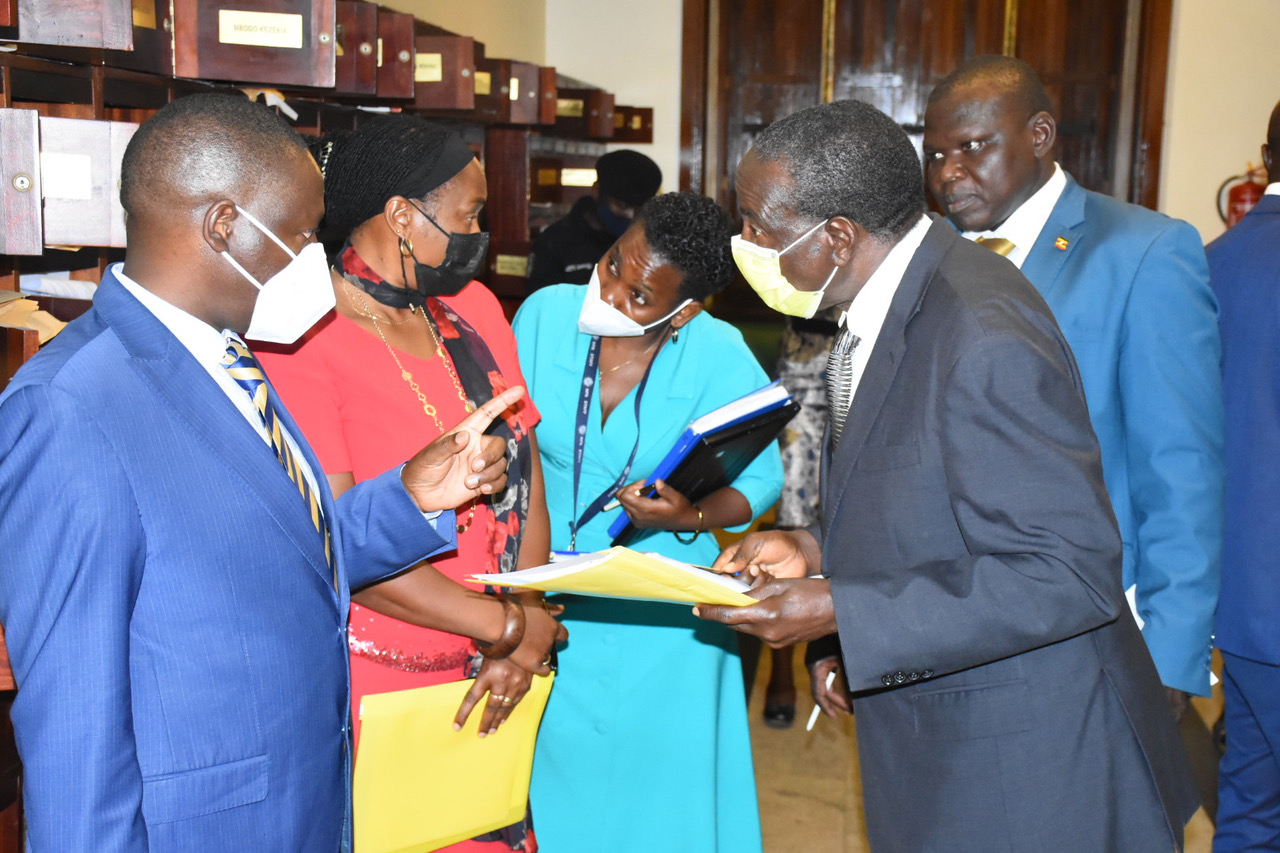Lawmakers task Kasaija on Shs66 trillion debt burden

Finance minister Matia Kasaijja (right) and State minister for Planning David Bahati (left) with other officials after appearing before Parliament’s Budget Committee on April 13, 2021. PHOTO/ALEX ESAGALA
What you need to know:
- On Monday, Daily Monitor reported that Uganda’s total public debt has hit a record Shs65.82 trillion as of December 2020, up from Shs49 trillion in 2019, due to increased government borrowing.
- As committee members pushed Mr Kasaija on the debt burden, Mr Bahati interjected and reasoned that the borrowed funds were used to finance sectors such as oil and gas, and transport as well as enabling Ugandans recover from the economic shocks occasioned by Covid-9.
Finance minister Matia Kasaija faced a barrage of questions about the country’s ‘distressing’ stock of total public debt that has grown from Shs46.36 trillion to Shs66 trillion in less than two years.
MPs on the Budget Committee tasked Mr Kasaija to explain what went wrong and how he intends to control the government appetite to borrow and bring the country’s debt burden back to convenient levels.
The country’s public debt is expected to grow to 52 per cent by the end of the 2020/2021 financial year, which is way above the 50 per cent threshold that Uganda agreed on with other partner states in the East African region.
The MPs led by their chairperson, Mr Amos Lugoloobi, however, had no kind words for Mr Kasaija and his colleague, Mr David Bahati, the Minister for Planning. They demanded for a detailed recovery plan to enable Uganda cure itself from the debt burden.
“The debt burden is unbearable. As a committee, we want to know how you are going to bring down this problem,” Mr Lugoloobi tasked the minister and his team.
“Are you going to be talking to the creditors? What’s your plan? Because the expenditures are beginning to increase and the revenues are continuing to become smaller? What assurances do you give Ugandans in dealing with this debt crisis?” he asked.
Minister’s response
In response, Mr Kasaija, attempted to explain that government will promote production to boost revenue to repay the current debt burden but the MPs kept interjecting, asking supplementary questions on the current debt crisis.
“I think the answer is in having the economy become more productive so that tax revenues can increase. That is the ideal answer,” Mr Kasaija said.
To reduce borrowing, the minister said government would promote production by providing incentives to manufacturers.
“We could give incentives to manufacturers and farmers if the money is available. That should be the ideal situation. So there is a need for us to encourage and do whatever we can for economic activities to increase. And when they increase, then our tax revenue will certainly increase,” Mr Kasaija said.
“I see very clear signs [of recovery] and I hope Covid-19 does not turn around to come and disturb us…. We need to control expenses and we should be very strict on this, including the Members of Parliament. It may come to a stage when we shall say [that] we can’t do this now,” he added.
However, citing government’s tendency to create more cities, districts and constituencies and other administrative units, the Kabula County legislator, Mr James Kakooza, said the minister’s suggestions were contrary to the prevailing situation.
In his response, Mr Kasaija said: “You know you can be overpowered. To tell you the truth, if I had the final say, I would never have allowed some of those things. But I am a servant of this State; there are people who are higher than me, so if they say ‘let’s do it’ it is very difficult for me to say no.”
Accountability
As committee members pushed Mr Kasaija on the debt burden, Mr Bahati interjected and reasoned that the borrowed funds were used to finance sectors such as oil and gas, and transport as well as enabling Ugandans recover from the economic shocks occasioned by Covid-9.
But Mr Kakooza said: “The strategy of getting a debt for investment should be carefully done, especially in areas, which can give you more revenue. But you [government] don’t put there more money. Look at the dairy industry; there is little investment done there by government yet demand for its products is high, especially in countries such as Tanzania.”
The ministers and their team were asked to return to the committee at an appropriate time with solid answers on how the government intends to deal with the debt crisis.
In January 2019, Mr Kasaija assured the country that public debt was sustainable, saying at end of June 2018, Uganda’s total public debt stock (domestic and external) amounted to $10.7 billion, which is equivalent to Shs38.483 trillion.
Mr Kasaija said then that out of this, external debt accounted for 67.2 per cent, representing $7.2 billion or Shs25.895t, while domestic debt contributed 32.4 per cent, which was $3.5 billion or Shs12.587 trillion.
Uganda’s public debt has been increasing in recent years due to increased government borrowing externally and domestically to finance public expenditures.
Background
On Monday, Daily Monitor reported that Uganda’s total public debt has hit a record Shs65.82 trillion as of December 2020, up from Shs49 trillion in 2019, due to increased government borrowing. This means that of the estimated 43 million Ugandans, each one owes lenders Shs1.5 million. The country’s public debt portfolio is projected to swell in the next financial year, with economists warning that it could surpass the 50 per cent threshold-hence becoming untenable. The latest Auditor General’s audit report indicates that although Uganda’s GDP has been increasing over the years since 2013/2014, its debt position has also increased.




